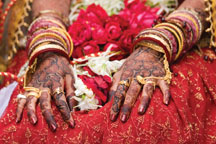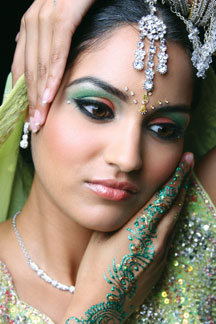Life
Marriage: Is love necessary?

How does the institution of arranged marriage, the culturally preferred way of Indians to establish the couple, square with the powerful dream of love?
| Love is one of the few constants left in a world that makes a fetish of cultural relativism. Erotic passion, with love’s tender discoveries, sudden torments, and consuming desires, is one of the last bastions of our common humanity. Young (and even older) Indians are no different from other human beings when they dream of capturing love’s freshness and spontaneity, free of all social restrictions and internal inhibitions, of becoming one with the beloved while overwhelming forces that would dampen desire and the urge to merge.
Arranged marriages are not only a pan Indian norm, cutting across the divides in education, social class, religion and regions but, more important, they are rarely seen as an imposition by the young people concerned who overwhelmingly prefer them to the love marriage typical of contemporary Western societies. Indian marriages are arranged to varying degrees depending on how much a young girl or boy participates in the process of selecting her or his mate. An extreme form is seen in Bollywood movies, that bastion of young love, where the lovers finally get married after defying the vehement opposition of their families. In the feeling of well-being produced by the movie’s happy end, we often fail to notice that the love marriage of the hero and heroine usually becomes an arranged one “after the fact” when one or other sets of parents withdraw their opposition to the love match and both sets of parents come together at the end of the movie to bless the couple.
The tension between these two different visions of what is the basis of family life is most visible in the sas-bahu – the cruel mother-in-law and the suffering daughter-in-law (including the eventual triumph of the younger woman over her older antagonist) stories that are the staple of many women’s songs, folktales and of widely watched TV soaps. Here, it is rarely recognized that the reviled mother-in-law is but an agent of the Indian family. Given the different organizing principle of the traditional Indian family, the new bride constituted a very real threat to the unity of the larger family. Abundantly aware of the power of sex to overthrow religiously sanctioned family values and long established social norms, the family was concerned that the young wife may cause her husband to neglect his duties as a son, as a brother, a nephew, an uncle; that he will transfer his loyalty and affection to her rather than remaining truly a son of the house.
Among Indians all over the world, love marriages are reputed to turn out to be generally unhappy. This reputation is more than a rumor, not because of the love between the young people that initiated the marriage, but because of the social attitudes that puts the marriage under enormous pressure. Perhaps the greatest attraction of an arranged marriage is the fact that it takes away the young person’s anxiety around finding a mate. Whether you are plain or good-looking, fat or thin, you can be reasonably sure that a suitable mate will be found for you. Although physical beauty is important for the Indian girl, it does not command the same premium in the selection of a partner as it does in Western societies. The beauty industry can certainly dip into the Indian woman’s latent desire to be beautiful, a desire she shares with all other women in the world. It cannot, however, as it does in the West, mobilize the woman’s fear of never finding a mate merely because she has not done enough to enhance her looks.
The dream of finding love does not disappear in an arranged marriage. This love, though, is a quieter affair, without the delicious delirium that can mark the periods of courtship and the beginning of a marriage in the West. Its feeling-tone is of contented togetherness rather than ecstasy. In other words, the dream of love remains necessary to a marriage. The difference is that in arranged marriages, it is expected that love will be less romantically or erotically imperious and that it does not have to prefigure marriage, but can waft in gently afterwards, sometimes years later when the couple is well into adulthood.
The tension between the two poles, the universal dream of passionate, erotic love and the cultural reality of arranged marriages, none of them easily discarded, continues to persist in the Indian psyche and often has poignant consequences for the emotional lives of a young Indian. In addressing a Western counterpart, the Indian would present her dilemma in Faust’s words: Your spirit only seeks a single quest so never learns to know its brother Two souls, alas, dwell in my breast And one would gladly sunder from the other. Yet, as in the case of Goethe’s Faust, many young Indians are aware that the presence of two souls in the breast can also be a fount of complexity and creativity, a sometimes painful enrichment of emotional life. |

 The central image of this dream of love is the couple that exerts a powerful pull on human imagination, with its deeply buried wish to be seen by the spouse as God might have done – that is, with absolute love and total understanding. How does the institution of arranged marriage, the culturally preferred way of Indians to establish the couple, square with the powerful dream of love? For in India the consensus in favor of arranged marriage through the centuries has been truly astonishing; in fact the only ancient Hindu text that considers love marriage as the highest form of marriage is the revolutionary Kamasutra.
The central image of this dream of love is the couple that exerts a powerful pull on human imagination, with its deeply buried wish to be seen by the spouse as God might have done – that is, with absolute love and total understanding. How does the institution of arranged marriage, the culturally preferred way of Indians to establish the couple, square with the powerful dream of love? For in India the consensus in favor of arranged marriage through the centuries has been truly astonishing; in fact the only ancient Hindu text that considers love marriage as the highest form of marriage is the revolutionary Kamasutra. The Indian preference for arranged marriage is partly based on the young person’s acceptance of the cultural definition of marriage as a family rather than individual affair, where harmony and shared values that come from a common background are more important than individual fascination. “We don’t marry someone just because of the shape of the curve of her hip and then rationalize it by claiming to have found a soulmate,” I heard a young Indian man say condescendingly to his American friend. More important, though, is the operation of a less conscious cultural norm that perceives the parent-son and filial bonds as the foundation of the family rather than the husband-wife tie exalted in some other societies. In the traditional Indian view, which still exerts a powerful influence on how even most modern Indians view marriage, the couple is not the primary constituent of the family as is taken for granted in modern Western societies.
The Indian preference for arranged marriage is partly based on the young person’s acceptance of the cultural definition of marriage as a family rather than individual affair, where harmony and shared values that come from a common background are more important than individual fascination. “We don’t marry someone just because of the shape of the curve of her hip and then rationalize it by claiming to have found a soulmate,” I heard a young Indian man say condescendingly to his American friend. More important, though, is the operation of a less conscious cultural norm that perceives the parent-son and filial bonds as the foundation of the family rather than the husband-wife tie exalted in some other societies. In the traditional Indian view, which still exerts a powerful influence on how even most modern Indians view marriage, the couple is not the primary constituent of the family as is taken for granted in modern Western societies. These are not either/or choices; however, custom, tradition and interests of the family demanded that in the in the realignment of roles and relationships initiated by the son’s marriage, the couple not take center stage, at least not in the early years of marriage. Signs of developing attachment and tenderness between husband and wife were carefully monitored and their development discouraged. Oblique hints about “youthful infatuation,” or outright shaming virtually guaranteed that the young husband and wife did not publicly express affection for each other. The much-maligned mother-in-law was no more than the family’s designated agent preventing the build-up of a “foreign” cell in the family body. Such overt struggles are fast disappearing in modern families, but their underlying rationale has left deep markings on the Indian psyche.
These are not either/or choices; however, custom, tradition and interests of the family demanded that in the in the realignment of roles and relationships initiated by the son’s marriage, the couple not take center stage, at least not in the early years of marriage. Signs of developing attachment and tenderness between husband and wife were carefully monitored and their development discouraged. Oblique hints about “youthful infatuation,” or outright shaming virtually guaranteed that the young husband and wife did not publicly express affection for each other. The much-maligned mother-in-law was no more than the family’s designated agent preventing the build-up of a “foreign” cell in the family body. Such overt struggles are fast disappearing in modern families, but their underlying rationale has left deep markings on the Indian psyche. Traditionally, there were, of course, objective conditions for the likelihood of the couple falling in love after marriage. The hormonal pressure created by enforced celibacy during youth, and a lack of experience with the opposite sex, ensured that the young person is biologically and emotionally primed to fall in love if the marriage partner is even reasonably satisfactory. In fact, arranged marriages work best, and perhaps can only work, if the sexes are kept apart in youth and if marriages are early, before young men and women have had an opportunity to compare a range of potential partners. But even among the more liberal members of the Indian Diaspora, the very existence of arranged marriage puts a mental roadblock in the way of a young person’s, especially a young girl’s, sexual experimentation, because of the possible blot on her reputation, which will make her soiled goods in the marriage market.
Traditionally, there were, of course, objective conditions for the likelihood of the couple falling in love after marriage. The hormonal pressure created by enforced celibacy during youth, and a lack of experience with the opposite sex, ensured that the young person is biologically and emotionally primed to fall in love if the marriage partner is even reasonably satisfactory. In fact, arranged marriages work best, and perhaps can only work, if the sexes are kept apart in youth and if marriages are early, before young men and women have had an opportunity to compare a range of potential partners. But even among the more liberal members of the Indian Diaspora, the very existence of arranged marriage puts a mental roadblock in the way of a young person’s, especially a young girl’s, sexual experimentation, because of the possible blot on her reputation, which will make her soiled goods in the marriage market.
You must be logged in to post a comment Login